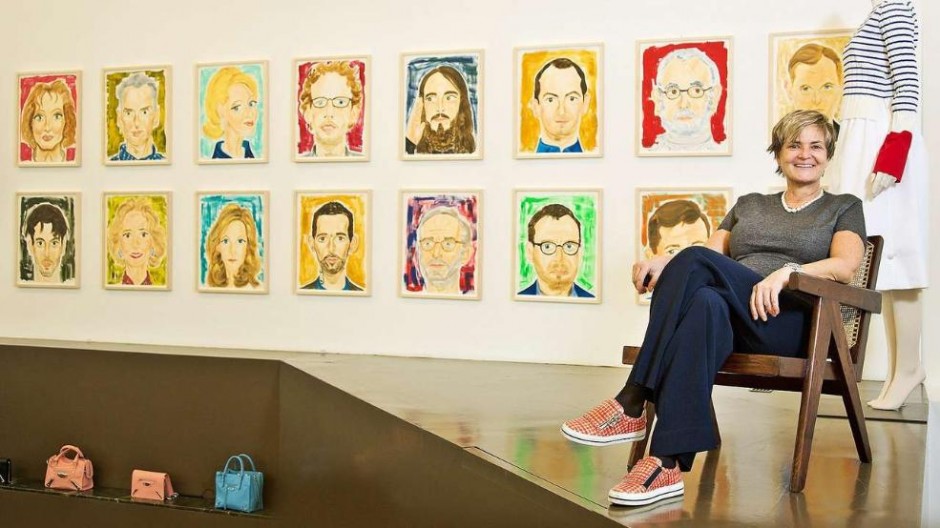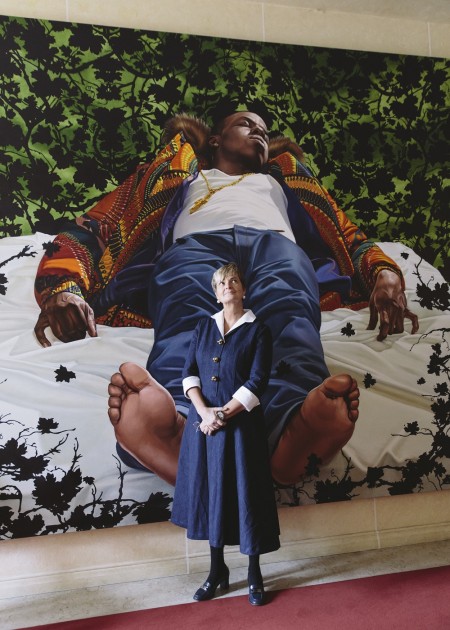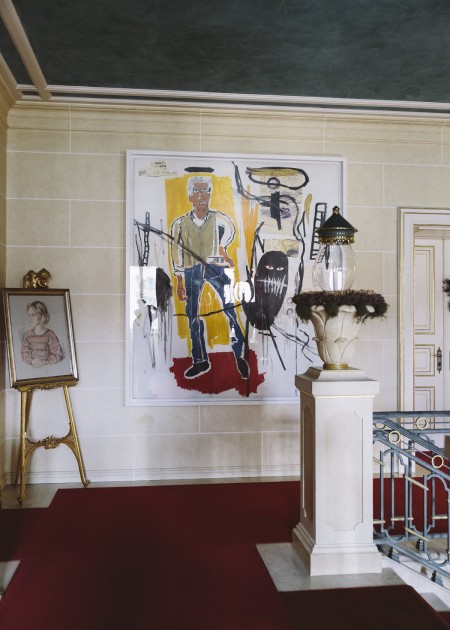A frequent guest to Andy Warhol’s Factory and residing in one of the largest privately owned palaces in the world, the Palace of St. Emmeram in Regensburg (Germany), Gloria, Princess of Thurn and Taxis belongs to one of the most prestigious royal families in Europe. She is one of the few people who rejected to be portrayed by Lucian Freud because he wanted her to sit six months for him – naked. Gloria, Princess of Thurn and Taxis is widely known as a successful businesswoman, globetrotter, motorbike lover and of course as an art collector.
Now she has turned into an artist herself. The glorious Galleria Borghese in Rome and galleries from Paris to New York displayed her portrait paintings over the last two years. Max Bossier and Christoph Noe had the honor to interview Gloria, Princess of Thurn and Taxis, about changing sides in the art world and were educated on the importance of being properly dressed – even during a Skype Call at midnight.

Christoph Noe (CN): Dear Gloria, Princess of Thurn and Taxis Now you are a painter, you are an artist. Why?
You are either an artist or you are not an artist. I have always been very creative because as children we were taught to paint. We were taught to play, to act, and we were taught to play music. This is the normal sort of education that you used to get in Germany back then. Some people followed it up and other people just didn’t use it anymore. I still play comedian acts. I still sing. I play music and I also paint.
CN: Was there a point when you said, “I want to show my artworks to the world”?
When I painted previously, I did it very privately. Then I got encouraged by my family and my friends. They really liked what I did, and they told me “you have to paint and you have to exhibit this stuff,” and that’s exactly what I did. I started to paint more, and as I gathered more paintings, I offered them for a show. My first show was in Rome in the attic of the famous Galleria Borghese. By that time, I only did pastel drawings. And then it evolved, and now I’m doing oil paintings, and watercolors. I try to use other media as well, such as video.
Max Bossier (MB): As I understood, your focus is clearly on portraits. Can you explain why?
When I first started to collect contemporary art, I always looked for portraits. I realized that they were very difficult to get because no artist – no fashionable or posh artist – wanted to do commissions back then. They hated doing commissioned portraits, which is quite understandable. Nonetheless I come from a tradition where portraiture is very important. My family had portraits from the eighteenth and nineteenth centuries on. Hence, it was only logical that I needed family portraits too, but there were no artists present in the contemporary art world who wanted to do that. Then I found Karen Kilimnik, and just a bit later Elizabeth Peyton – she paints portraits too, but I don’t think she takes commissions. Andy Warhol was the only one who did commissioned portraits. David Hockney painted portraits but I don’t know of any commissions he did. And of course there was Lucian Freud.
MB: We know that Julian Schnabel did a portrait of you too. What about Lucian Freud?
I do have a wonderful portrait, a plate painting, by Julian Schnabel. When I met Lucian Freud in the early 1980s, he asked me if I was willing to sit for a portrait. Of course, that was very flattering, but he wanted me to be naked, so I turned this offer down. I was very young and too shy. Furthermore, there was another challenge: he wanted me to come to his studio for six months, every day. As a young mother, I did not have enough time.
MB: You said that you were too young. Does that mean that you would do it today?
No way! No way, darling! I wouldn’t do it!
CN: Let’s speak about your paintings and your portraits again. Why did you choose portraiture as your genre?
I decided to paint portraits because very few painters do portraiture. I’ll give you second reason: I am a dilettante. In the best sense of the word, I’m a dilettante. Nonetheless, when going through the art fairs, you see a lot of dilettantish artworks. I felt in very good company and I thought: “If professionals produce dilettantish work, it’s totally OK to be a dilettante.
MB: What do your artist friends think about your portraits?
Basically, they laugh about it. There are a few artist friends who really like what I do, and they really encourage me, like Jeff Koons, Cindy Sherman, and Julian Schnabel. Schnabel even made me a compliment. He said the painting that I did of him looked like Alex Katz, only better. At the same time, he is very critical and he doesn’t take me seriously at all, which I think is totally okay. I don’t need to be taken seriously!

CN: I have a lot of Chinese artist friends, and I know they love to barter: I give you an artwork of mine; you give me an artwork of yours. Is this also a currency you are trading?
Well, this would really be a big compliment for me. If a professional artist, a full-time artist, would offer me a trade, I would be really honored. So far, only Cindy Sherman has offered me a trade. To be honest with you, I would never take her up on this since whatever she creates is so much more valuable than what I do. I think it’s almost impolite to ask for an exchange. You have to “keep it real” and stay with your feet on the ground, and you have to know where you are. I’m a part-time-fun-hobby-painter. I really love what I do, and I think it’s a wonderful thing to paint. Painting makes you happy. Painting makes you really happy. But singing makes you happy, too.
CN: Tell us a little bit about the process of painting. Do the people you paint sit in front of you as a model? Or do you paint from your memories or from photos?
I don’t like people to sit for me, because this raises too many expectations plus people get impatient. I rather use images. Also, I take paintings from the nineteenth century and transform them into my paintings. I like to look at photos, but I don’t really like to have somebody sitting in front of me. I’ll do it if I have to, but that’s not what I feel comfortable with.
CN: How do you access the market? Are you selling your works directly or are you represented by a gallery? In which price range are your works sold?
I don’t have a contract. I have a galley in New York, “The National Exemplar Gallery”, which gave me a solo show in 2015. Basically you can hire me to do your painting, and I’ll do it. For an oil painting, 18 by 24 inches (46 x 61cm), I would charge $3,000.
CN: When you are going to an art fair or an exhibition, do you still feel the need to collect artworks from other artists?
Absolutely. I still love to go shopping, and I really like to go shopping for art. I must admit that I’m not a fan of art fairs anymore. I don’t like the frenzy so much, because I always get the feeling that if I’m not the first customer in the morning, then I’m the loser. I like to go to galleries and look at museum shows. If I really want something, I can find it without visiting art fairs.

MB: You have been collecting for decades. Do you think that collecting art has changed over the time? Has it become more competitive?
Let’s face it: a very good development has taken place. Art is a commodity. It should be a commodity because it was already a commodity in the eighteenth century and earlier, even in the fourteenth and fifteenth centuries. Art was always something desirable, and more people have money now than before. People who have money want to decorate their homes. People want to show how cultivated they are, and they can do it best by displaying art. Art is something that makes you very happy. It’s quite natural that a lot of people want to have access to art. That’s why the art fairs are so popular.
When I started collecting back in the 1980s, it was a little bit more of a closed community because there were way fewer galleries. There was Leo Castelli, Ilena Sonnabend, Mary Boone and Larry Gagosian was just starting out. He was a young man back then. I sort of grew up with those galleries, and in their program every single artist was fabulous. The market has grown and grown and grown. When we went to art fairs, it was easy to be there first, because the other collectors were not as crazy as they are today.
CN: Do you think that collecting art cultivates people?
I strongly believe that by having art in your house and by collecting, you become more cultivated. It’s not like putting on a suit and a tie. If you dress differently, you walk differently and you talk differently. When you start to deal with the arts—I don’t mean dealing in the sense of making money, but dealing with art by going to museums and going into artist studios—you become more cultivated. It’s an educational tool. You don’t necessarily have to buy the art. There is definitely a cultivation process taking place if you visit museums regularly. Also, it doesn’t hurt to look at the art of the earlier centuries, because then you can place it into context with contemporary art.
MB: Speaking about the art of the earlier ages, what kind of art are you focusing on when you look for new artworks to collect?
I like young artists. Lately, I was offered a very nice artist, which I really like. He’s called Titus Schade. He comes from Leipzig. An even more known artist I am following is Friedrich Kunath. I really like young and emerging artists. I always look for originality. I want a surprise. I want humor. I want fun. I want nothing that takes itself too seriously.

CN: Your family owns a castle in Regensburg, where you present your art. Would you call it a contemporary museum?
No, it’s not a contemporary museum. It’s a castle and it’s about the architecture and the interior design of the nineteenth century. It’s like a time warp. You start in the Middle Ages. You start in the thirteenth century, and you finish off in the nineteenth century. You basically walk through the architecture of four centuries.
Visitors can see my domestic collection scattered around the museum because we still live there. The charm of our museum is that you’re basically walking into one of the largest private castles in the world. What makes our castle in Regensburg charming is that it is alive because we live there. You really visit the home of a family. And here you can also stumble over some contemporary art. Nonetheless, our visitors are mainly people who are interested in the history of our family and the culture of the past in the medieval city of Regensburg.
CN: How much of your time do you now dedicate to being an artist? How much time do you dedicate to being a collector?
Art in general takes up about 50% of my time, whether it is visiting a museum or painting. The rest of my time is dedicated to my family and business.
MB: Can you give some advice to young collectors? How should they start?
Young collectors should just stroll through galleries and fairs around the world. Just look, look, look, look and see, see, see, see. The brain can handle all this. There won’t be overkill. The more you see the better. You will find out pretty soon what you like, but your taste might be really bad. You have to form your taste. In the beginning, you can’t rely on your taste because you don’t naturally have taste. Nobody has taste. You have to learn about it. You have to be humble, and also you have to listen to experts and you have to read magazines. That’s the way you can be taught what taste is all about. Visit many private collections as well! When you are educated, then you can go out and buy stuff.
CN: Dear Gloria, Princess of Thurn and Taxis, thanks for your time. We are excited to see your next exhibition.
A commisioned oil painting, 18 by 24 inches (46 x 61cm), by Gloria, Princess of Thurn und Taxis costs $3,000. Would you like to get more information about the portraits? Please write to us at contact@larryslist.com.

Related:
Portraits by Gloria, Princess of Thurn und Taxis
Royal Family of Thurn und Taxis
A selection of artists Gloria collects:
Keith Haring
Andy Warhol
Julian Schnabel
Jean-Michel Basquiat
Kehinde Wiley





